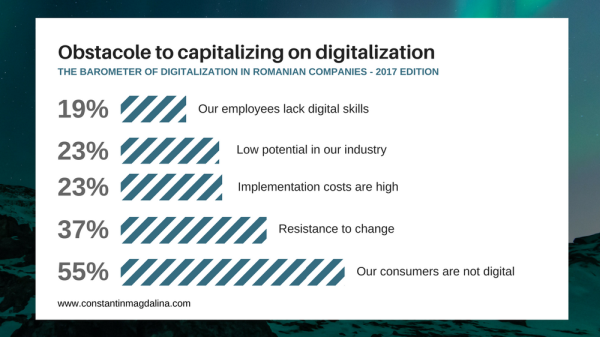One goes on holiday with all the virtual friends. But companies also seem to be on vacation in this respect. Now the messages from the virtual environment have a special characteristic. We see ice cream and cocktails on the companies Facebook pages. We see groups of friends rafting, paragliding or enjoying the wonderful underwater geography.
Companies become people who want to accompany their consumers virtually. The virtualization of the experience of interacting with potential customers is an indicator of companies' adherence to digitalization. Still, when asked about digitalization, many companies say they either do not have digital consumers and do not have digital skills, or that digitalization contributes to improving decision-making through analytics.

These contradictory responses that were gathered in Valoria's Barometer of digitalization in Romaniashow that digitalization brings both obstacles and benefits. Here are the most important of these:
· Obstacles to digitalization– The main obstacle that 55% of companies see to the digital transformation is the very perception they do not have digital consumers. This indicates the need for a better understanding of the mechanisms of digital interaction with consumers, as on average 60% of the purchasing process is conducted online, whether B2B or B2C. In the second place, 37% of companies even recognize their own resistance to change as an obstacle to digitalization.
· Benefits of digitalization– The most important cumulative benefits of integrating the digital transformation process over the next 5 years are: cost savings (46%), process simplification (46%), increased operational efficiency (35%), better measurement of company performance (34%), improving decision-making with data analytics (33%). The last place is held by the benefit of facilitating the recruitment and retention of employees (3%).
Companies that have been strongly influenced by digitalization consider in the highest percentage (12%) than others that digitalization contributes to improving the decision-making process through data analytics. Companies that were moderately influenced are the ones who most believe that digitalization increases their reputation and corporate brand (10%). Companies that are just slightly influenced by digitalization are those that, compared to the others, consider that they can amplify the positive consumer experience through digitalization (13%).
· Increased revenue by 10% through digitization– 63% of the Romanian companies want to deploy intelligent operational management systems to be able to generate 10% more revenue over the next 5 years through digitalization. In second place, we find Big Data and Data Analytics with 50%, followed by IoT (Internet of Things) devices in third place by 49%.
We note that virtual and augmented reality, artificial intelligence and industrial robots are not part of the major digital tactics of the companies greatly of moderately influenced by digitalization. By contrast, the least or not so far influenced by digitalization are more open to the implementation of industrial robots. However, 20% of the companies that are strongly influenced by digitalization and 29% of the moderately influenced companies expect the Internet of Things to increase their revenues over the next 5 years.
For companies in Romania, digitalization moves within the framework outlined by the perception that they do not have digital consumers, that there is a lack of digital skills and the implementation costs are too high. This perspective also leadsto the responses regarding the joint benefits with these barriers to digitalization, such as the ability to better measure company performance, simplify processes and reduce costs. So, we see that for companies in Romania, the decoding of the transformations brought about by digitalization is done more in terms of risk and less of opportunity. The frame of reference will adjustas the implementation of the technology will highlight other benefits of digitalization. In this case, the transition to a different way of thinking goes through another way of acting.





























